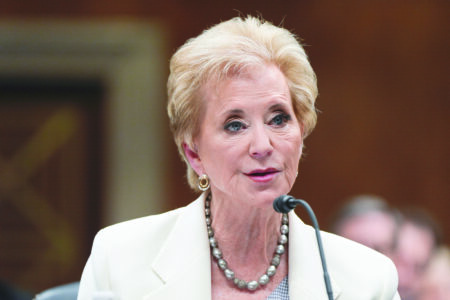Billions diverted from K-12 schools
Michigan League for Public Policy looks at funding tactic

Aspen Ridge Elementary School second-graders Nolan Heikkinen, left, and Jack Salmi look at the glazed owls they made in art class in March. A grant from Michigan Youth Arts, on behalf of the Michigan Council for Arts and Cultural Affairs, paid for the supplies. However, not every education program in Michigan can be funded through a grant. (Journal photo by Christie Bleck)
MARQUETTE — Legislators have diverted $4.5 billion from K-12 schools over the past eight years, according to a new report recently released by the Lansing-based Michigan League for Public Policy.
This includes $637 million in lost K-12 funding for the 2017-2018 school year and a record high of nearly $1 billion for the 2018-2019 school year.
Noted in the report, “A Hard Habit to Break: The Raiding of K-12 Funds for Postsecondary Education,” the Michigan Legislature has diverted $4.5 billion from the School Aid Fund and K-12 schools to higher education since 2009.
Begun as a one-time “loan” under Gov. Jennifer Granholm during the Great Recession, the Snyder administration has made shifting SAF dollars away from kids and K-12 schools to community colleges and universities one of its primary budget tactics — a move the MLPP said is paying for significant tax cuts for businesses and the wealthy.
“Over the past eight years, the exception unfortunately became the rule, and using School Aid Fund dollars for higher education went from a last resort to the first order of business,” said Gilda Z. Jacobs, president and CEO of the Michigan League for Public Policy, in a prepared statement. “Just because you can do something doesn’t mean you should. While this gimmick may be legal, it is morally and fiscally irresponsible, and lawmakers should put an end to the practice immediately and permanently.”
The ploy has been used in every state budget of Gov. Snyder’s tenure, with an increasing percentage of the total community college and higher education budgets coming from School Aid Fund dollars, the report said. Three of the past five state budgets have funded community college operations entirely from the SAF, and the most recent budget more than doubles the SAF dollars going to universities. This accounts for a third of their funding.
Before 2009, the higher education and community college budgets were funded entirely from the General Fund.
The report also points out that in Governor Rick Snyder’s first budget for Budget Year 2012, the nearly $400 million taken from K-12 schools was accompanied by a $470 per-pupil cut in the K-12 foundation allowance –the only year since Proposal A in which the foundation allowance was statutorily cut. The cut was accompanied by a large tax cut for businesses that cost $1.6 billion, with only part of that amount made up by increased taxes on individuals.
Recent increases to the SAF and per-pupil spending have barely returned to their 2011 levels, the report said. When accounting for inflation, the 2018 minimum allowance of $7,631 was equal to only $6,780 in 2011 dollars –a 7 percent drop in purchasing power and roughly $1,000 below where it should be.
In June, Gov. Snyder signed the Fiscal Year 2019 Education Omnibus budget into law. The budget provides a per-pupil increase of $120 to $240 in K-12 schools. According to the Governor’s Office, the budget sets per-pupil funding at $7,781 for schools at the minimum allowance and $8,409 for schools at the maximum allowance, for a gap of $538.
The Michigan School Finance Research Collaborative, a nonpartisan group of education experts, school officials, business leaders, public policy advocates — including the MLPP — and others, has recommended that schools receive a base cost of $9,590 per pupil, with additional funding weighted by the number of students in poverty, the number of English language learners, district size and geographic isolation, up to a maximum of $11,482.
Jacobs said that instead of setting priorities over who receives funding,
legislators should be funding all of the state’s top priorities, and that requires revenue and investment, not tax cuts.
The report listed items for which the $4.5 billion could have been used had the money remained in the SAF:
≤ Increasing the foundation allowance;
≤ Fully funding Early On, Michigan’s early intervention program that identifies and serves infants and toddlers with developmental delays;
≤ Fully funding the At-Risk School Aid program, which provides state funds to schools to help students at risk of failing academically or who are chronically absent;
≤ Increasing funding for early literacy; and
≤ Expanding preschool and early learning programs such as increased funding for the Great Lakes Readiness Program for 4-year-olds and expanding it to 3-year-olds.
The MLPP report’s conclusion was that Gov. Snyder and the Legislature should put 100 percent of the SAF toward financing levels recommended by experts. It also involves funding universities and community colleges at adequate levels using General Fund dollars and other appropriate federal and local funding sources, and addressing General Fund shortfalls by increasing revenue sources rather than shifting educational funds away from their intended purpose.
Peter Ruark, MLPP senior policy analyst, worked on the report throughout the summer.
“Our mission is to advocate for public policy that helps struggling individuals and families and promotes economic opportunity for all, so education is a very big part of that,” Ruark said in a telephone interview with The Mining Journal.
Ruark acknowledged he usually works on post-secondary education issues, and that’s how he noticed more of that type of education was being funded through the SAF.
He said the MLPP believes a graduated income tax would solve a lot of revenue problems that in turn could alleviate the SAF problem.
“This is ultimately a revenue issue,” said Ruark, who noted revenues need to be in the budget to keep up with tax expenditures.
“We must stop raiding the School Aid Fund for other purposes,” he said.
Christie Bleck can be reached at 906-228-2500, ext. 250. Her email address is cbleck.miningjournal.net




